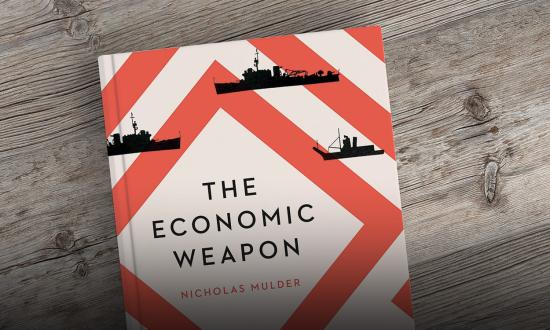War Without Rules: China’s Playbook for Global Domination
Where is the battlefield? The answer: Everywhere.
Two Chinese People’s Liberation Army (PLA) colonels, Qiao Liang and Wang Xiangsui, asserted this concept and others in their 1999 book Unrestricted Warfare. The colonels reflected on, among many other topics, how the face of war would change, given the U.S. preeminence demonstrated both in its coalition victory in the First Persian Gulf War and its commanding position in the international economic and diplomatic orders.
Brigadier General Robert Spalding argues that Unrestricted Warfare is both the playbook for a broad, undeclared Chinese war against the United States and a critical lens through which policymakers and average citizens should interpret Chinese Communist Party (CCP) actions. War Without Rules seeks to explain the challenging prose, logic, and colloquialisms of Unrestricted Warfare that remain even after a translation to English. Spalding builds on the thesis of his prior book, Stealth War (Portfolio, 2019). Referencing his experience as both a senior U.S. defense official and defense attaché to China and senior director for strategic planning in the National Security Council, General Spalding works to causally tie CCP actions to Unrestricted Warfare’s dictums.
If the only rule of unrestricted warfare is that there are no rules, then what other variants of war exist? The two PLA colonels propose a long list of “wars” from which Spalding finds modern examples. Psychological or media warfare, via China’s rampant use of misinformation, censorship, or efforts to separate the United States from its allies. Environmental warfare, through U.S. concessions in exchange for diplomatic assent to reduced carbon emissions goals that China has, as demonstrated by its building of more coal power plants, no intention of achieving. Drug warfare? Similarly, dishonest CCP pledges to crack down on illegal exports of fentanyl to U.S. shores, fueling an opioid epidemic that kills thousands and costs billions.
From economic aid “warfare” (in the Belt and Road Initiative) to working to co-opt international institutions during the COVID-19 pandemic, Spalding is comprehensive in outlining the totality of CCP mendacity and malfeasance through the frame of Unrestricted Warfare. Further reinforcing the two colonels’ prescience are the numerous reflections on Osama bin Laden and terror warfare, the enduring American obsession with maintaining a technological edge, and the U.S. political system’s belief in war as distinct from peace. Qiao Liang and Wang Xiangsui saw that bin Laden was fighting an unconventional war, one that would expend American blood and treasure. That we would prove them right over two decades was sobering.
War Without Rules is no doubt a blistering critique of the Chinese Communist Party. However, the book’s compelling argument suffers for two reasons. First, the many modern examples of Chinese unrestricted warfare against the United States rely on seemingly arbitrary citations. Second, the book’s partisan perspective is evident throughout, which may further estrange some policymakers or voters, despite a desire that “we should all be China hawks.” These critiques do not argue that the information asserted is necessarily wrong. Nonetheless, given the weight of accusations against Chinese and U.S. organizations and even named individuals, a comprehensive citation regime and bibliography would have greatly reinforced War Without Rules.
For those interested in examining myriad examples of Chinese coercion against the U.S.-led international order, War Without Rules provides such cases in spades. For more skeptical China doves, it may be less convincing. For this reader, the book is a good introduction to accepting an inversion of Clausewitz’s maxim to meet the China challenge: that policy is a continuation of war through other means.
Lieutenant Cregge is a surface warfare officer. He served on a destroyer, cruiser, and aircraft carrier as an air-defense liaison officer. He is a future SWO department head.
The Age of AI and Our Human Future
Henry A. Kissinger, Eric Schmidt, and Daniel Huttenlocher. Boston: Little, Brown and Company, 2021. 272 pp. Notes. Index. $30.
Reviewed by Captain George Galdorisi, U.S. Navy (Retired)
As technologies such as big data, artificial intelligence (AI), and machine learning have proliferated, it should come as no surprise that the number of books focused on these subjects has also mushroomed. The Age of AI and Our Human Future is one of the newest entrants into this growing body of work.
The middle of the book’s cover is dominated by two of its authors, Henry Kissinger and Eric Schmidt, both notables who need no introduction. The reader is therefore made ready to enjoy a narrative offered by two experts in their respective fields: Kissinger with his expansive worldview and Schmidt with his experience as the former Google CEO and now cochairman of the National Security Commission on Artificial Intelligence.
A one-word description of this book is “aspirational.” The authors (the third author is computer scientist Daniel Huttenlocher) envision a world in which virtually every promise of AI (the commonly used abbreviation for the three technologies presented in the first paragraph) is realized and there are no barriers to its adoption. The “AI Winter” —the three decades from the mid-1960s to the mid-1990s when support (and funding) for AI research completely collapsed—receives only a one-paragraph mention.
To say that the authors are advocates for all that AI can bring to the human race is hinted at in the book’s subtitle: Our Human Future. Other words could be used: proponents, champions, promoters, even—not to be unkind—zealots. One quote from their narrative is especially germane: “AI will transform all realms of human experience.”
This prediction is dangerous and exposes one of the weaknesses of the book. The AI Winter in the last century was caused by AI being vastly over-hyped only to dramatically underdeliver. “All realms of human experience” is a powerful term. One has to ask: Would more ubiquitous AI have had an impact on Russia’s invasion of Ukraine? Could AI stem gun violence? Could AI have prevented the more than one million COVID-19 deaths in this nation?
That said, The Age of AI and Our Human Future does provide a breezy overview of these technologies and what could occur if they advance along a steady path. For readers who have only a passing knowledge of AI and related technologies, this book could serve as a useful primer and, perhaps, an inspiration to learn more about the subject.
However, for those with a more nuanced understanding of the promises—as well as the perils—of widespread AI adoption, this book does not advance the corpus of work on the subject and will likely leave the informed reader a bit let down. Put this book on your airplane or beach read list if you want to join the proponent’s club, but not if you are looking for a serious deep-dive on this important subject.
Captain Galdorisi is the Director of Strategic Assessments and Technical Futures for the Naval Information Warfare Center Pacific. His most recent books are AI at War: How Big Data Artificial Intelligence and Machine Learning Are Changing Naval Warfare (Naval Institute Press, 2021) and Fire and Ice (Braveship, 2021).
The American War in Afghanistan: A History
Carter Malkasian. Oxford, UK: Oxford University Press, 2021. 576 pp. Maps. Figs. Notes. Gloss. Biblio. Index. $34.95.
Reviewed by Major Brian A. Kerg, U.S. Marine Corps
The war in Afghanistan came to a climactic and tragic end with the final withdrawal of U.S. forces on 30 August 2021. In the wake of America’s longest war, many of those who lived through it find themselves in a quest for understanding. The war began with a rapid invasion by U.S. forces in 2001 and their rapid defeat of the Taliban. Nearly 20 years later, Afghan security forces and the Kabul government collapsed as the Taliban returned to power in an equally dramatic fashion. How did this happen, and what does it mean? Carter Malkasian’s The American War in Afghanistan offers the most comprehensive and sensible answers to date. Placing the U.S. conflict within the context of a 40-year-long Afghan civil war, Malkasian guides the reader through the entire saga, providing rigorous analysis at every step.
Malkasian sets out chiefly to explain how the war in Afghanistan ended so disappointingly for the United States and its allies. His central thesis is that the Taliban represented what it meant to be Afghan, and this connection was the essential element in enabling U.S. defeat. Carefully avoiding any insinuation that Islam is inherently violent, Malkasian demonstrates that defending Islam and resisting foreign occupation are part and parcel to Afghan identity. The Taliban offered a central organization that inspired followers to fight and die for a cause vital to the Afghan people, while the United States and the tumultuously divided Afghan government in Kabul did not.
However, Malkasian does not depict the Taliban as an undefeatable foe. Instead, he shows that defeat was enabled by a number of strategic failures. The Afghan government and its warlord allies often treated the Afghan people poorly and did not offer reliable governance, driving many Afghans into the arms of the Taliban. And while there was fighting spirit to be found among the Afghan security forces, the army, police, and tribal militias lacked unity and often fought as separate actors in support of competing interests. This made it easier for the more resilient and unified Taliban to fight and defeat a numerically superior better trained and supplied opponent.
Neither does Malkasian paint a fatalistic picture of a war that could have never been won. He identifies the decisions the U.S. government made, across four separate presidential administrations, that might have avoided defeat or reduced the costs of the war. He illustrates this as a window of opportunity that was initially quite broad, but that closed over time through grave diplomatic and policy errors, changes in the Afghan security situation, and changes in the U.S. domestic situation.
This book grapples with another dilemma, weighing whether the United States did more harm than good during its nearly 20 years in Afghanistan. Nation building, reconstruction, and civil affairs are through-lines of this saga, and improvements to Afghan health, education, and urbanization are clear. Still, the author finds the costs far more dire: Hundreds of thousands of Afghans were killed, hundreds of thousands more were displaced, and a deepening of extremism hardened the Taliban’s ties to al Qaeda and allowed for the introduction of the even more fanatical Islamic State.
The American War in Afghanistan is a masterful explanation of America’s longest war. It will prove to be a keystone for practitioners and scholars of national security, foreign policy, and history. Perhaps more than that, it offers a clear path for understanding a wildly complex war. Most attempts to glean meaning from this conflict require us to look through a glass darkly. Malkasian offers a clear lens and a guiding light.
Major Kerg is a prior-enlisted mortarman, communications officer, operational planner, and nonresident fellow with Marine Corps University’s Brute Krulak Center for Innovation and Future Warfare. He currently is the Northeast Asia Plans Officer at III Marine Expeditionary Force.
The Digital Silk Road: China’s Quest to Wire the World and Win the Future
Jonathan E. Hillman. New York: Harper Business, 2021. 351 pp. Notes. Index. $29.99.
Reviewed by Captain Sam J. Tangredi, U.S. Navy (Retired)
The internet and the digital age were predicted to ensure the triumph of democracy over authoritarianism. In 1989, former President Ronald Reagan eloquently captured this belief, saying, “The communications revolution will be the greatest force for the advancement of human freedom the world has ever seen.” A common belief during this era of globalization was that the global sharing of information would force the Chinese Communist Party (CCP) and other dictatorships to moderate their social controls. Instead, as Jonathan Hillman points out, communications—and particularly cyberspace—have always been “a powerful tool, for liberation or repression, depending on who controls it.” The “digital silk road” is Hillman’s metaphor for the CCP’s efforts to dominate, and thereby control, the overall global communications network. By many indicators, it is winning this competition.
Hillman is a senior fellow of the influential Center for Strategic and International Studies and director of its Reconnecting Asia Project. The book reflects his expertise as it traces the events leading to the market dominance of CCP-subsidized Huawei and other Chinese companies in winning the networking business of both economically developing nations and cost-conscious sectors of the Western world.
Like all Chinese companies, Huawei acts as an agent—whether avowedly or slightly reluctantly—of the CCP, which concluded in the 1980s that “countries with advanced networking technology rely on networks to expand their ‘information territory’ to many other countries and threaten the latter’s ‘information sovereignty.’” Hence, the best way for authoritarian regimes to preserve their “information sovereignty” and resist any external or internal pressure for democracy is by expanding into and potentially controlling the “information territory” of other states—particularly in the West.
This is also convenient for intelligence gathering; Huawei and other Chinese internet service providers routinely route their global network traffic through servers in China, increasing accessibility to the CCP. There is no free and open market here.
Many national security professionals are now aware of this, and recent presidential administrations have started the tough effort of convincing allies and partner nations to resist employing Chinese-built networks. It is a tough effort indeed since subsidization (indirect as well as direct) by the CCP allows Chinese telecoms to offer the lowest prices (plus government-backed loans to customers). Ironically, this was facilitated by Western telecoms thirsting after the huge Chinese market for technology.
It is Western business people who need to hear Hillman’s message even more than national security professionals. His unique contribution is to uncover the fact that almost every major Western telecom that attempted to partner with Chinese businesses (and the CCP) as a dominant element of their business plans—Motorola and Nortel being two of the largest—went bankrupt. First, their Chinese partners gained (natural) access to their business skills and strategies. Then the CCP forced “technology sharing” through regulations and restrictions. Eventually the Chinese partners siphoned off enough knowledge—through industrial espionage, reverse engineering, or simply hiring away their personnel—to compete against and undercut their Western “partners.” The few Western companies that avoided this fate did so because the (presumed) China market potential was kept a small part of their business or they pulled back from CCP mandates.
Unfortunately, business people and other national security professionals are unlikely to absorb this message from Hillman’s volume because the book is somewhat repetitive and too long. The Digital Silk Road would be more effective as a series of articles or a well-distributed report half its length. In fact, one-third of the book—almost 100 pages—consists of endnotes.
No one can argue that the book is not well researched. Few can argue that Hillman’s message is not a critical lesson for preserving the future of freedom. On the other hand, it is hard to maintain that it is an engrossing and pleasurable read.
I would urge the author to concentrate on shorter literary bursts in a continuous volume of fire rather than a ponderous book-length salvo that misses the targeted audience. The message is just too important to be drowned.
Captain Tangredi holds the Leidos Chair of Future Warfare Studies at the U.S. Naval War College. In addition to being a frequent contributor to Proceedings, he has published seven books.










